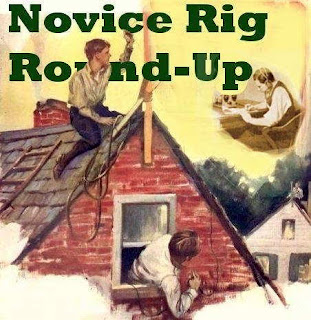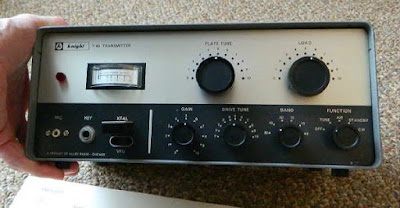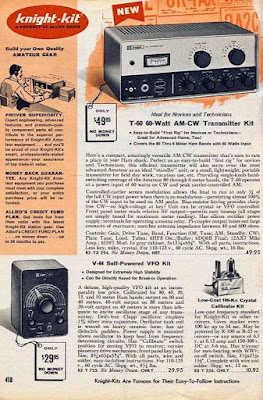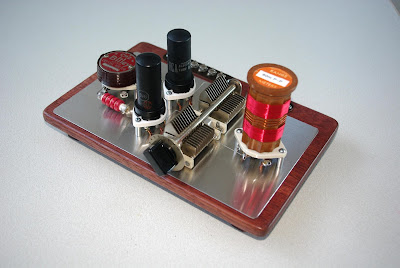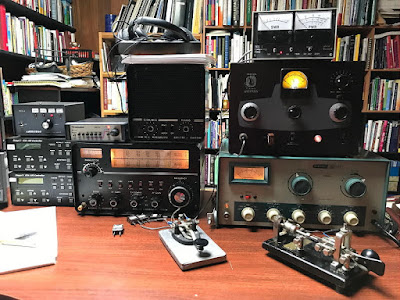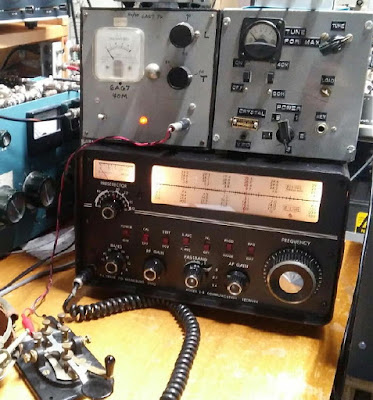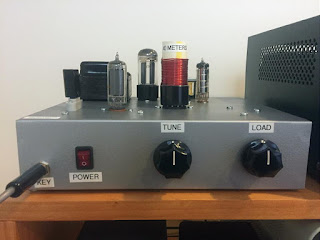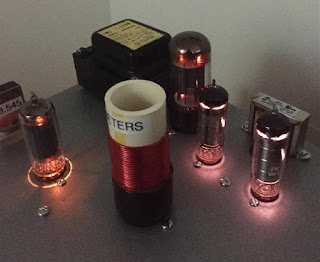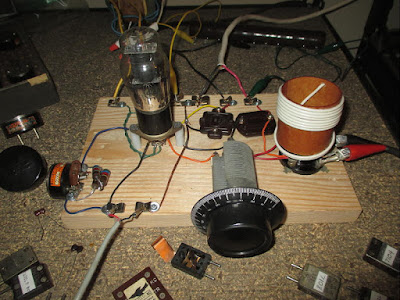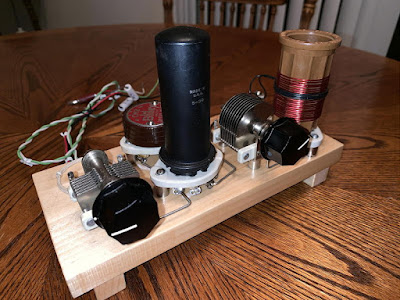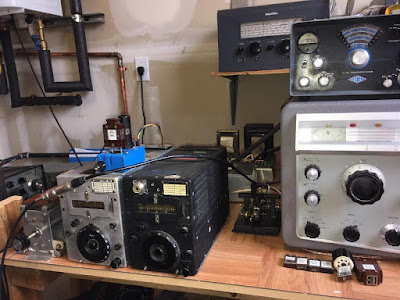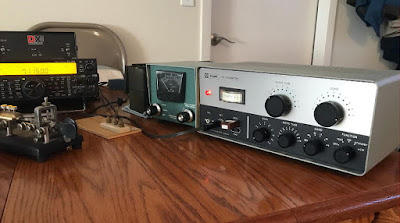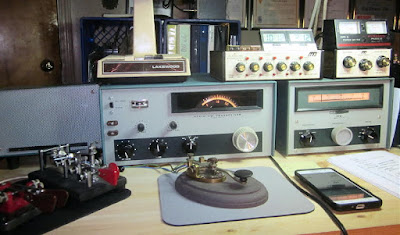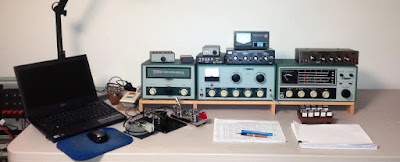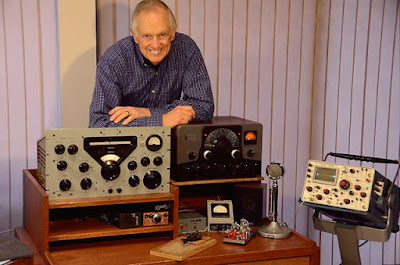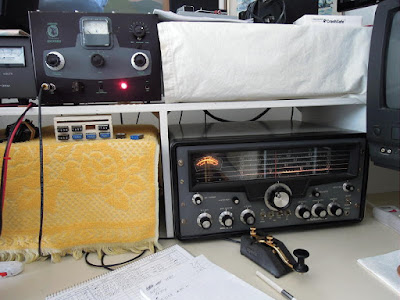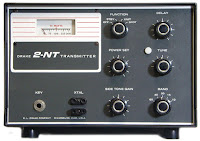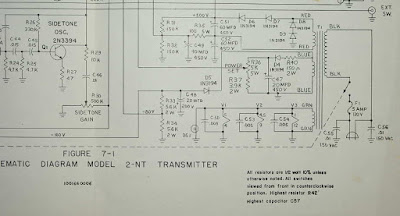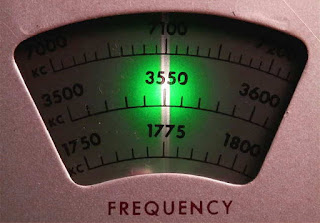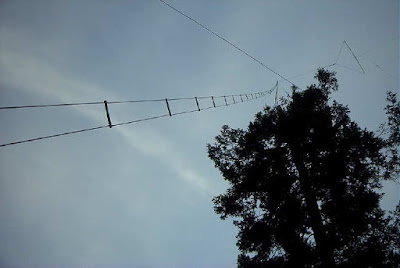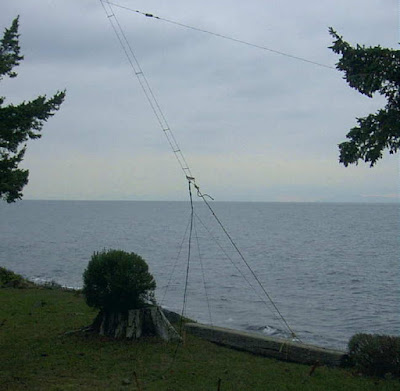Posts Tagged ‘Novice Rig Round-Up’
 Here Comes The Novice Rig Roundup (NRR) 2020!
Here Comes The Novice Rig Roundup (NRR) 2020!
One of the most enjoyable operating events of the year is fast approaching -- the Novice Rig Roundup or 'NRR'. Technically, it is a contest, but I have the feeling that most participants think of it as just a lot of fun and a nice opportunity to hear and work some of the great old 'classics' of the past -- rigs that were used when they were teenage Novices or rigs that they could only drool about owning, back in those formative years when they each discovered the magic of radio.
Once again the bands will be alive with the sounds of Heath AT-1s, DX-20s, DX-35s, DX-40s and DX-60s, Johnson Adventurers, Eico 720s, Drake 2NTs, Knight T-50s and T-60s, Ameco AC-1s and of course, an endless variety of lovingly-constructed homebrew delights and ... a full week plus two weekends to celebrate the 'good old radio days' of their teen years, as many of us remember them.
The dates to remember are 0000 UTC March 7 to 2359 UTC March 16 and this multi-day opportunity is, for me, what makes the NRR so enjoyable. With a nice diversion from the usual 'contest frenzy' associated with standard weekend operating events, the NRR can be enjoyed throughout the week, whenever you choose to participate. If last year's operating patterns continue, you should find activity at any time of the day ... and even more as sunset arrives.
With the fast-approaching solar minimum, we will be hard-pressed to relive the glory days of worldwide 15m propagation, but many transcon contacts were made during last year's event thanks to some well-timed solar activity! With a little luck and, hopefully, a well-timed solar flare, we may get lucky! If you operate during the daylight hours, please get on 15m and give it a shot ... and be sure to announce your activity on the NRR's sked and chat page here, so that others will know where to find you, especially if you are rock bound in true Novice fashion. With our present spotty conditions, we need all the help we can get and the sked page proved a very valuable asset during last year's affair.
Although technically not required, if you plan to participate it's best to obtain your own NRR number, which is an easy 30-second process.
Additionally, there is an online logger where participants can post their daily log. The nifty logger also keeps track and figures out your score as it goes and no 'after contest' log needs to be submitted. If you plan on submitting a log, the logger is a requirement. The logger will also require you to set up a 'log-in' and once again, a simple 30-second process will take care of that from here. If you used the logger last year, you will have to set it up again for this year as the old system has been changed.
Stations may run either crystal-control or VFO or can switch between either method ... the online logger will keep track and score things appropriately.
All of the rules and information can be found on the NRR's excellent website. As well, the soapbox comments and station pictures from last year's NRR may provide the inspiration that you need to spark-up your own activity in this year's event ... from what I can tell, this year will be bigger and busier than ever!
There is also a dedicated NRR Group, often the source of much valuable discussion but there is a now HUGE group of great NRR chat and activity now on Facebook's NRR Group here. I avoided Facebook for many years and have now discovered that it is an excellent forum for real time chat and information exchange ... one can still choose to maintain a very low profile and avoid unwanted interaction if set up correctly.
In 2017 I ran my homebrew Longfeller in the (now eliminated) QRP category, and had a ton of fun. You can read about it here. Last year, I refurbished a nice Drake 2NT that had been gathering dust in the basement for over 25 years and ran it during the 2018 NRR. You can read about my activity and some of the rigs encountered during last year's fun here.
If you have access to the web while operating, be sure to bookmark and check into the NRR's realtime chat page. Many ops that are crystal controlled will announce their operating frequencies, making it easier for you to find them ... sometimes way up or down from the normal NRR watering holes of ~ 3550 - 3650 kHz, 7100 -7125 kHz, 21.100 - 21.150 MHz and 28.114, 28.120 MHz ... and don't forget to check the colorburst crystal frequency of 3579!
'CQ'ers should always remember to tune up and down the watering hole for replies from other NRR stations that may be crystal controlled and not able to answer you on your own frequency!! This is extremely important and a real reminder of what was common practice back in the Novice days.
 |
| courtesy: Harry - VE7AIJ |
You still have time to get that old clunker on the air but if that's not possible, you can join the fun with your modern rig as well ... all are welcome to jump in and have a great week of radio-fun. I think you will be surprised, just as I was last year, how good some of these old classics can sound ... and you'll hear some great bug-fists as well.
Need more inspiration? ... here's a summary of my own experience of the 2018 NRR:
***********************
The NRR once again provided many notable highlights over the nine day event.
Almost topping the list was just experiencing the variety of old classics and hearing how well almost all of them sounded. Numerous Knight T-60s, Drake 2NTs, Heath DX-40s, Johnson Adventurers and Eico 720s, along with a nice variety of homebrew MOPAs and one-tube power oscillators graced the nightly airwaves. These oft-forgotten shelf-queens always seem to develop super-powers, far beyond their expectations, when the NRR rolls around!
I was really surprised to work so many T-60s, a small and inexpensive 60 watt transmitter kit from 1962 using a popular 6DQ6 television sweep tube ... one never expected to achieve such RF greatness! I was very impressed with every one that I heard.
What radio-struck pre-Novice teen, dreaming about getting on the air, could resist a clever ad like this.
Scott, KA9P's 80m T-60 signal sounded as sweet as it looks in his 2018 setup, paired with his Heathkit HR-10B inhaler.
 |
| KA9P 2018 NRR station with RAF Vulcan bomber Type 51 hand pump |
Right up there with the plethora of T-60s was the Drake 2NT, another great sounding radio and also my choice for this year's event. My summer refurbishing project, described here, proved a worthy companion, although my much-treasured VF-1 VFO's short term drift probably had my 2NT getting red in the face whenever I took her off of crystal control to scurry around the band, seeking out the CQ'ers. I've had a love-hate relationship with the VF-1 ever since buying my first one back in '63!
 |
| VE7SL 2018 NRR with 2NT, VF-1 and my Original '63 Vibroplex |
Yet another 2NT packed a powerful punch from West Virginia, keyed by Dave, W3NP, when we exchanged 579 reports on 40m, 45 minutes before sunset.
 |
| W3NP - 2018 NRR setup |
I made three contacts on 15m this year: W5IQS in Texas, K2YWE in Maryland and WN4NRR in Florida, whose S9 reply to my 'CQ NRR' just about took my head off ... what a nice surprise to hear the booming signal from Bry's 2NT powerhouse. Dan, K2YWE, was no slouch either, as his Globe Scout was music to my ears when his signal quickly rose out of the noise just long enough to make the coast-to-coast journey. If the predictions for future solar cycles become reality, there may be many more NRRs before we experience the magic of 15m once again.
 |
| K2YWE's Globe Scout and Adventurer were worked on all three bands! |
My NRR exchanges with George, N3GJ (KA3JWJ) in Pennsylvania, truly demonstrated just how well the low bands were performing. More than an hour before my local sunset, I responded to his 569 40m 'CQ NRR' only to learn that his signal, now reaching a solid 579, was coming from an original Ameco AC-1! This one-tube crystal-controlled power oscillator has, over the years, reached Holy Grail status among many amateurs. Originals are guarded like precious jewels and handed down from father to son ... or in George's case, from uncle to nephew!
 |
| N3GJ and his all powerful original AC-1 |
Heathkits were plentiful too, with the DX-60 seeming to be the rig of choice, often paired with the matching HG-10 VFO. Both Mark, VA7MM and Gary, W8PU, packed a wallop with these fine examples.
 |
| VA7MM - 2018 NRR set-up |
| W8PU - 2018 NRR set-up |
But it wasn't just DX-60s representing Benton Harbor engineering in the NRR. All of these neat old Heaths made it out to the west coast, sometimes on both 40 and 80. KN8RHM's (Rick) HW-16 made it here on 40m with a solid signal almost every night, while KE4OH (Steve) sported a modernized DX-20 in the form of Heath's HX-11. Steve even received the highly-treasured 'OO' report for his NRR chirp ... good job!
| KN8RHM - HW-16 NRR set-up |
 |
| KE4OH - HX-11 NRR station |
| N3PDT - DX-40 NRR transmitter |
Rich, WN7NRR / AG5M operating in nearby Washington state put some of his 44 crystals to work with his HW-16 ... that's some collection!
| WN7NRR - HW-16 NTT set-up |
Howie, WB2AWQ in Reno, was using his homebrew pair of 807s, driven with a Millen 90700 swing-arm VFO from 1945. Most shacks worldwide, including the Novices, found plenty of use for the 807 as they were dirt-cheap in the post war surplus market. The filament has a beautiful illumination and if a bit gassy as most are by now, emit a wonderous blue glow with each press of the key.
 |
| WB2AWQ - 807s |
 |
| Millen VFO from 1945 at WB2AWQ |
| KD7JG's 1625 NRR mainstay |
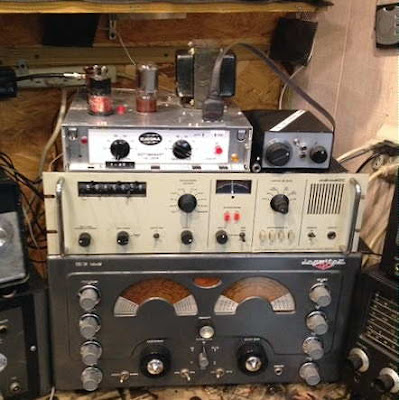 |
| K4IBZ's 10 watter |
 |
| AA8V's homebrew NRR stack |
 |
| VE3BDV / VE3AWA - 50C5 Bare - Essentials power oscillator |
I finished up the NRR with 123 contacts, a lot better than last year's event when I was running the Longfeller at 5 watts.
As indicated on the NRR website, this is "more of an EVENT than just a typical contest ... once again taking our OLD ham radios off the shelf and putting them to use again! "
See you in the 2020 NRR!
 My 2019 Novice Rig Roundup Summary
My 2019 Novice Rig Roundup Summary

Once again the Novice Rig Roundup (NRR) has come and gone ... and once again, it was the most enjoyable 'contest' of the year for me.
What I have come to enjoy most about the NRR is that most participants do not really treat it as a contest but more as an opportunity to spend some relaxing CW time enjoying some of their favorite vintage rigs ... spread out over nine days of activity. Since there was never a Novice-class program in Canada, I was never a Novice, but the NRR brings back all of the good memories experienced as a newly-licenced radio-crazed 15 year old operator!
Back in those times, there was a gratifying sense of achievement with every contact. My clap-trap collection of parts and tin gutter-pipe verticals, mounted atop our old four-story city house, magically sent my tiny signal from coast to coast and over the pole.

Those were the dying days of big-daddy Cycle 19, and my station was proof that just a tiny bit of RF was all that was needed under such amazing solar conditions.
This year's NRR began by making a couple of contacts with my Drake 2NT and VF-1 VFO but my newly-finished 1936-style Jones Push Pull Oscillator was begging to be put to the test. This meant that the remainder of the week would be spent using crystal-control and in all likelihood, sending a hundred or more 'CQ NRR's, hopefully attracting some of the crowd.
Due to previous commitments, I missed a few nights of operating but ended up with 53 NRR contacts in 23 different states or provinces. Operating on 40m in the late afternoon and then for a short period on 80m after dinner, proved to be the best use of my time, as usually, much of the eastern activity had closed shop for the night, just as the band was getting good. There were two nights of superb 80m propagation but with very little NRR activity ... unfortunately for many participants, late-night operating (even with wonderful propagation) is not in the cards for those that must rise early for work the next morning!
There were several highlights for me once again and being able to create them while using my new homebrew rig was very gratifying.
Roger, VA1RST, back in Halifax, Nova Scotia, was one east-coaster that seemingly cherished the midnight-oil! His great Drake 2B ears were able to copy the little 'Jones' on 80m with no problem and his participation added an exotic DX-flavor to the NRR.
Michael, W3TS, managed to squeeze enough RF from his one-tube 6AG7 crystal oscillator to be heard and worked here on both 40 and 80m, with a respectable 559 on 40 and 569 on 80!
It wasn't until after the NRR was over that I realized why Mike's call was familiar as we had worked a couple of times already this winter on the 630m band (475kHz) ...doh!
More transcon magic was made when Tom, K3AJ, finessed a few watts from his single 6CL6 crystal-controlled DX-machine to the west coast on both 80 and 40m. The propagation gods must have been paying close attention as his 40m signal was a solid 579 while his late-night 80m signal was a whopping 589 here ... 80m propagation just like the good old days!
Not to be outdone by Tom, ex-Nebraskan Andy, KØSM in New York, kept his vintage '42' clipped together long enough to be worked back here as well. With just a couple of watts from the early '30s tube, his signal was no problem on both bands.
Gary, W8PU, with his newly-built mid-30s 6L6 tri-tet oscillator, was another treat from the east when his 559 80m signal arrived here from Ohio in good form.
A little closer to home, WB2AWQ, Howie down in Reno, had a whopping signal all week whenever I heard him on 40m. Howie can always be counted upon for 'NV' in most vintage rig operating events, including the 1929 BK Party. This time 'round, he was using his BC-458A, crystal-controlled at 35 watts out. It's a good bet that hundreds of Novices got their start with a surplus Command set such as this, which often sold for just a few dollars in the 50s ... still new in the box!
Even closer was new Oregonian, Dave, WB7WHG, who was still getting set up at his new location on the east side of the Cascades in Bend. Dave keyed his Knight T-60 for our NRR contacts on both 80 and 40 and was very much louder than when I used to work him at his midwest WB9WHG QTH!
The T-60 is a popular choice among NRR ops and it's diminutive size is somewhat misleading as the current-hungry sweep tube used in the PA stage packs a big wallop. If you happen upon one of these under a fleamarket table, don't pass it up ... it"s a lethal NRR weapon!
Heathkit stations were as popular in the NRR as they were in countless Novice shacks decades ago ... and they sound just as good now as they did back then.
KN8RHM (N8XI), Rick, made Michigan proud with his HW-16 transceiver, while Mark, VA7MM, handed out 126 contacts from western Canada with his all Heath vintage station. His newly added homebrew TR switching system provided hands-free break-in, saving wear and tear on the DX-60's precious function switch.
Not many Viking Rangers were heard this year but the one keyed by Markus, VE7CA, sounded very 50s-like with its oscillator being crystal-controlled for the event.
K9SB, Tim, used his Johnson Adventurer and Hallicrafters SX-101A vintage setup as well as a vintage Drake station to hand out 'IL' to many NRR ops.
There seems to be no shortage of era-appropriate Novice gear out there but as the years progress, it will get harder and harder to find and probably more expensive to own. It's wonderful to see so many amateurs that understand and appreciate this older gear and are doing their best to keep it all working ... and the NRR is just one of many opportunities to let these old beauties demonstrate their capabilities.
From what I can tell, NRR activity continues to increase every year and will hopefully be even bigger next year. If you were a participant, don't forget to get your log completed along with your photos and soapbox comments, all of which can be done through the NRR website here. If you enjoyed the NRR, all run by volunteers, consider making a small monetary donation to keep the event going. You can do this via the NRR site as well.
If you're one of the many NRR participants that didn't want the event to end, don't forget that every Monday is the NRN (Novice Rig Night). A short 'CQ NRN' in the usual CW watering-holes, will often provide some nice rag chew time with like-minded operators.
Thanks to all organizers and participants for the CW fun and for another great ride in the NRR time-machine ... see you again next year!
 The 2019 Novice Rig Roundup (NRR)
The 2019 Novice Rig Roundup (NRR)
One of the most enjoyable operating events of the year is fast approaching — the Novice Rig Roundup or ‘NRR‘. Technically, it is a contest, but I have the feeling that most participants think of it as just a lot of fun and a nice opportunity to hear and work some of the great old ‘classics’ of the past — rigs that were used when they were teenage Novices or rigs that they could only drool about owning, back in those formative years when they each discovered the magic of radio.
Once again the bands will be alive with the sounds of Heath AT-1s, DX-20s, DX-35s, DX-40s and DX-60s, Johnson Adventurers, Eico 720s, Drake 2NTs, Knight T-50s and T-60s, Ameco AC-1s and of course, an endless variety of lovingly-constructed homebrew delights and … a full 9 days to celebrate the ‘good old radio days’ of their teen years, as many of us remember them.
The dates to remember are 0000 UTC March 2 to 2359 UTC March 10 and this multi-day opportunity is, for me, what makes the NRR so enjoyable. With a nice diversion from the usual ‘contest frenzy’ associated with standard weekend operating events, the NRR can be enjoyed throughout the week, whenever you choose to participate. If last year’s operating patterns continue, you should find activity at any time of the day … and even more as sunset arrives.
With the fast-approaching solar minimum, we will be hard-pressed to relive the glory days of worldwide 15m propagation, as even last year’s event proved to be tough on this band. With a little luck and, hopefully, a well-timed solar flare, we may get lucky! If you operate during the daylight hours, please get on 15m and give it a shot … and be sure to announce your activity on the NRR’s sked and chat page here, so that others will know where to find you, especially if you are rock bound in true Novice fashion. With our present spotty conditions, we need all the help we can get and the sked page proved a very valuable asset during last year’s affair.
Although technically not required, if you plan to participate it’s best to obtain your own NRR number, which is an easy 30-second process.
Additionally, there is an online logger where participants can post their daily log. The nifty logger also keeps track and figures out your score as it goes and no ‘after contest’ log needs to be submitted. If you plan on submitting a log, the logger is a requirement. The logger will also require you to set up a ‘log-in’ and once again, a simple 30-second process will take care of that from here. If you used the logger last year, you will have to set it up again for this year as the old system has been changed.
Stations may run either crystal-control or VFO or can switch between either method … the online logger will keep track and score things appropriately.
All of the rules and information can be found on the NRR’s excellent website. As well, the soapbox comments and station pictures from last year’s NRR may provide the inspiration that you need to spark-up your own activity in this year’s event … from what I can tell, this year will be bigger and busier than ever!
There is also a dedicated NRR Yahoo Group, often the source of much valuable discussion but there is a now HUGE group of great NRR chat and activity now on Facebook’s NRR Group here. I avoided Facebook for many years and have now discovered that it is an excellent forum for real time chat and information exchange … one can still choose to maintain a very low profile and avoid unwanted interaction if set up correctly.
In 2017 I ran my homebrew Longfeller in the (now eliminated) QRP category, and had a ton of fun. You can read about it here. Last year, I refurbished a nice Drake 2NT that had been gathering dust in the basement for over 25 years and ran it during the 2018 NRR. You can read about my activity and some of the rigs encountered during last year’s fun here.
If you have access to the web while operating, be sure to bookmark and check into the NRR’s realtime chat page. Many ops that are crystal controlled will announce their operating frequencies, making it easier for you to find them … sometimes way up or down from the normal NRR watering holes of ~ 3550 – 3650 kHz, 7100 -7125 kHz, 21.100 – 21.150 MHz and 28.114, 28.120 MHz … and don’t forget to check the colorburst crystal frequency of 3579!
‘CQ’ers should always remember to tune up and down the watering hole for replies from other NRR stations that may be crystal controlled and not able to answer you on your own frequency!! This is extremely important and a real reminder of what was common practice back in the Novice days.
 |
| courtesy: Harry – VE7AIJ |
Harry’s homebrew 6AQ5 crystal oscillator (Feb ’55 Popular Electronics) and Hallicrafters S-53, pictured above, allowed him to work the world back in the amazing radio days of Cycle 19. Let’s relive some of that excitement in the closing days of Cycle 24 … in the NRR!
You still have time to get that old clunker on the air but if that’s not possible, you can join the fun with your modern rig as well … all are welcome to jump in and have a great week of radio-fun. I think you will be surprised, just as I was last year, how good some of these old classics can sound … and you’ll hear some great bug-fists as well.
As indicated on the NRR website, this is “more of an EVENT than just a typical contest … once again taking our OLD ham radios off the shelf and putting them to use again! “
See you in the 2019 NRR!
 Monday’s ‘NRN’ CW Fun
Monday’s ‘NRN’ CW Fun
 |
| My homebrew Ameco AC-1 clone |
A weekly CW operating activity that seems to be growing in popularity is the Monday “NRN”.
The NRN get-togethers are an offshoot of the annual “NRR” or Novice Rig Roundup. Monday’s “Novice Rig Night” gradually grew from those that wanted to see the NRR fun continue, in one form or another, without waiting an entire year for the event to roll around again.
Operating times run from sunup on the east coast to midnight on the west coast ... but basically, people just get on the air whenever they can on Monday and call “CQ NRN”. I suspect that most of the activity takes place between late afternoon and bedtime, with 40m probably seeing the most action. As winter arrives, we may see more activity on 80m but these are only my personal observations from the west coast.
Most folks are using typical Novice-era transmitters and / or receivers, with the Drake 2NT, early Heathkits, Eicos, homebrews and Hammarlunds being popular. The previous Monday I was active with my homebrew Ameco AC-1 clone, a 6V6 crystal power oscillator, at about 6 watts out. Good contacts were had with several eastern stations. There are several AC-1s around and there has been at least one suggestion of an 'AC-1 Night' ... what fun that would be as well!
For last night’s NRN, I brought out my homebrew Paraset.
Once again, good contacts were had with the easterners on 40m: W9BRD in NJ, W3NP in WV, KD2E in NJ and VE3LYX using his No.19 tank radio ... two WWII radios talking to each other in 2018, one real and one a reproduction!
 |
| VE3LYX's No.19 set operating position |
Here is the formal announcement for the Monday events, with a few additional details. Hopefully you can join the fun (any rig is fair game!), next week.
 The 2018 Novice Rig Roundup (NRR)
The 2018 Novice Rig Roundup (NRR)
One of the most enjoyable operating events of the year is fast approaching -- the Novice Rig Roundup or 'NRR'. Technically, it is a contest, but I have the feeling that most participants think of it as just a lot of fun and a nice opportunity to hear and work some of the great old 'classics' of the past -- rigs that were used when they were teenage Novices or rigs that they could only drool about owning, back in those formative years when they each discovered the magic of radio.
 |
| WN4HQW's '62 Novice station (now N4CF) |
The dates to remember are 0000 UTC March 3 - 2359 UTC March 11 and this multi-day opportunity is, for me, what makes the NRR so enjoyable. With a nice diversion from the usual 'contest frenzy' associated with standard weekend operating events, the NRR can be enjoyed throughout the week, whenever you choose to participate. If last year's operating patterns continue, you should find activity at any time of the day ... and even more as sunset arrives.
With the fast-approaching solar minimum, we will be hard-pressed to relive the glory days of worldwide 15m propagation, as even last year's event proved to be tough on this band. With a little luck and, hopefully, a well-timed solar flare, we may get lucky! If you operate during the daylight hours, please get on 15m and give it a shot ... and be sure to announce your activity on the NRR's sked and chat page here, so that others will know where to find you, especially if you are rock bound in true Novice fashion. With our present spotty conditions, we need all the help we can get and the sked page proved a very valuable asset during last year's affair.
Although technically not required, if you plan to participate it's best to obtain your own NRR number, which is an easy 30-second process.
Additionally, there is an online logger where participants can post their daily log. The nifty logger also keeps track and figures out your score as it goes and no 'after contest' log needs to be submitted. If you plan on submitting a log, the logger is a requirement. The logger will also require you to set up a 'log-in' and once again, a simple 30-second process will take care of that from here.

Stations may run either crystal-control or VFO or can switch between either method ... the online logger will keep track and score things appropriately. Stations running in both Novice 1 and Novice 2 categories (probably most common), will be eligible for prizes in both modes if they make at least ten contacts using a Novice 1 station or if they work ten Novice 1 category stations.
All of the rules and information can be found on the NRR's excellent website. As well, the soapbox comments and station pictures from last year's NRR may provide the inspiration that you need to spark-up your own activity in this year's event ... from what I can tell, this year will be bigger and busier than ever!
There is also a dedicated NRR Yahoo Group, often the source of much valuable discussion.
Last year I ran my homebrew Longfeller in the (now eliminated) QRP category, and had a ton of fun. You can read about it here. This year, I have refurbished a nice Drake 2NT that had been gathering dust in the basement for over 25 years ... it's all ready to go now, but a problem with the VF-1 VFO has arisen. The combination works well on 40m and above but on 80 it's a different story. The VFO runs on 160m and it seems that the 2NT balks at the idea of doubling in the buffer stage to 80m. Unless I solve the problem, I'll be rockbound on 3579, 3550 or 3560kc. ... it was 'kilocycles' back then, which always seemed to make more sense to me than 'kilohertz'.
If you have access to the web while operating, be sure to bookmark and check-in to the NRR's realtime chat page. Many ops that are crystal controlled will announce their operating frequencies, making it easier for you to find them ... sometimes way up or down from the normal NRR watering holes of ~ 3550 - 3650 kHz, 7100 -7125 kHz, 21.100 - 21.150 MHz and 28.114, 28.120 MHz ... and don't forget to check the colorburst crystal frequency of 3579!
Of course with the large number of rockbound stations (on crystals), be sure to look above and below these frequencies. It's good practice to listen well above and below your own frequency as well, for anyone answering your CQ who may be up or down the band on crystal control. Unlike today, this was very common practice back in the Novice days!
 |
| courtesy: Harry - VE7AIJ |
You still have time to get that old clunker on the air but if that's not possible, you can join the fun with your modern rig as well ... all are welcome to jump in and have a great week of radio-fun. I think you will be surprised, just as I was last year, how good some of these old classics can sound ... and you'll hear some great bug-fists as well.
As indicated on the NRR website, this is "more of an EVENT than just a typical contest ... once again taking our OLD ham radios off the shelf and putting them to use again! "
See you in the 2018 NRR!
 Drake 2NT And The Novice Rig Roundup (NRR)
Drake 2NT And The Novice Rig Roundup (NRR)

One of this summer's radio workbench projects was to refurbish my Drake 2NT transmitter for this winter's NRR event. The 2NT was introduced in 1966 with the 'novice' ticket-holder in mind, selling for $129. It was the first and only CW-only transmitter produced by R.L. Drake.
As novice transmitters go, the 2NT was a cut above some of the others out there, boasting interesting features such as a built-in antenna changeover relay, sidetone oscillator, grid-block keying and built-in low pass filter.
The tune-up procedure was simplified as well and with Drake's reputation for quality construction, the 2NT became a popular choice for Novices and Generals alike.
My own 2NT was purchased, along with the matching 2C receiver and speaker/Q-multiplier combo over 25 years ago at a Washington state ham fleamarket. Ever since then they have been patiently sitting on the shelf, trying to catch my attention.
The motivation and much-deserved attention finally arrived this year after enjoying last winter's NRR and hearing several great-sounding 2NT's on 80, 40 and 15m CW. I operated the week-long Roundup with my homebrew 'Longfeller' at 5W output, in order to qualify for the QRP category.
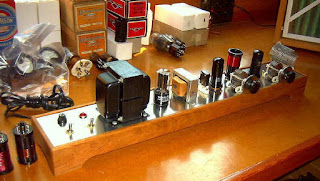 |
| 6AG7 - 6V6 'Longfeller' |
I eventually ended up with 68 contacts, but at 5W, it was a challenge ... most of my many 'CQ NRR' offerings were unanswered, so it was mostly a 'search and pounce' operation. With this in mind, I soon decided that next time, I'll get the 2NT ready to go and hopefully, with a little more oomph, can attract some callers.
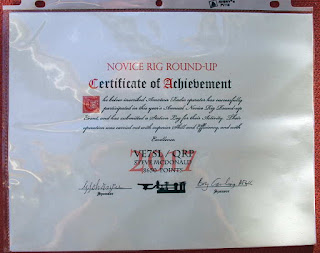 |
| Each entrant received an NRR certificate - a nice touch |
Rather than hunt down and purchase the individual replacement electrolytics, especially the multi-unit can capacitor which was impossible to source, I ordered the '2NT re-cap kit' from Hayseed Electronics. They supply replacement kits for several boatanchors and are able to make and stuff multi-section can capacitors to match the original size and specs ... and all at affordable prices.
After cleaning the chassis and all of the switches, re-tubing with new tubes and removing / replacing all of the electrolytics, the 2NT was ready to go. Using a crystal for excitation, the following results were obtained:
80m 103W input 75W output efficiency = 73%
40m 92W input 65W output efficiency = 71%
20m 92W input 65W output efficiency = 71%
15m 92W input 55W output efficiency = 58%
10m 92W input 50W output efficiency = 54%
Keydown voltages averaged ~520V while plate current ranged from 170-200ma. All-in-all, right on target and not bad for a 51 year old transmitter!
The 6EA8 modified Pierce oscillator in the 2NT seems particularly 'crystal-friendly', as every old style FT-243 style crystal that I tried sounded great. Even the newer ones from AF4K using a modern HC-49 crystal slab mounted inside a vintage FT-243 holder sounded great and worked perfectly.
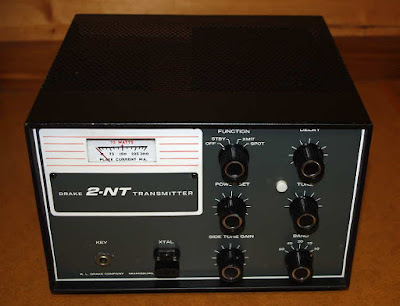 |
| My newly refurbished 2NT - ready to go |
A couple of days later, I returned to the bench to take some blog photos of the rig delivering power into the wattmeter. When I turned the 'stby' switch to 'transmit', the plate current suddenly shot up (with no keying) and the meter on my Variac supply indicated over an amp being drawn by the power transformer ... all with zero output and no crystal plugged-in!
A look at the schematic diagram revealed that with the grid-block keying system, the final amplifier's cathode is always grounded and a low voltage negative bias applied to the grid keeps the plate current cut-off until being keyed ... with cut-off bias missing, plate current will soar, along with transformer primary current. I suspected that something had gone haywire with the bias supply.
A quick check of the 2NT's printed circuit board containing the bias system components among others, indicated a discolored silicon rectifier (D5) in the bias supply. An in-circuit measurement revealed that it was indeed shorted, basically supplying raw AC across the filter capacitor and shorting out the transformer winding, quickly elevating the transformer's temperature in the bargain ... not good.
Although the diode only has to handle a small amount of current, it was mounted with a heat-producing 2W resistor straddling its top surface. As well, the phenolic circuit board was noticeably discoloured from the heat. I suspect this was the main reason that D5 eventually failed.
My 2NT was an early one, serial #670, so perhaps this parts-arrangement was re-engineered in later models. Once the diode was replaced with a much smaller modern one, of twice the rating, everything returned to normal. The last thing I would want to do at this stage is to burn out the transmitter's unique power transformer, undoubtedly impossible to replace nowadays.
The next bench project will be to refurbish and improve the stability of my Heathkit VF-1 VFO and to mate it with the 2NT.
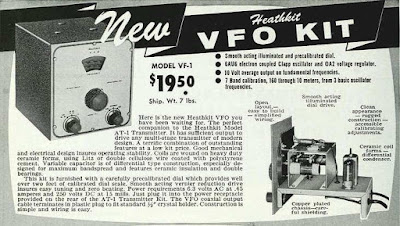 |
| '55 QST VF-1 ad |
Another small quirk noticed on my 2NT is the meter mount. My early model has the meter mounted so low that the silk-screened 'PLATE CURRENT MA.' label is not clearly visible when looking straight-on.
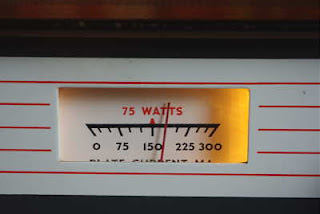 |
| My #670 |
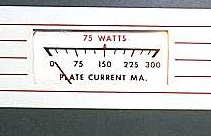 |
| Later models |
You can read many interesting soapbox comments and see some nice NRR station photos from the previous two events here and here, but read with caution as you could easily get hooked. I find pages like this very inspiring and they remind me of the days when QST would publish photos, soapbox comments and exacting equipment descriptions used by each section winner in the annual November Sweepstakes contest.
 |
| Winner's gear in '55 CW SS - remember these? |
 Novice Rig Round-Up Report
Novice Rig Round-Up Report

Last week's Novice Rig Round-Up delivered far more enjoyment than I ever imagined!
Operating from the left coast and choosing to limit my output power to 5 watts, I really didn't expect to work more than a half dozen stations or so. The week-long event included two weekends, providing plenty of opportunity for participants to spark-up their novice-class rigs or their favorite pre-80's 'boatanchors' ... and they did!
I had 68 contacts with other 'NRR' stations, working numerous Heathkits, Drakes, Johnsons and homebrewed favorites ... even a Collins KWS-1! Staying true to the 'novice' class spirit, most were using hand keys and a surprising number were even using crystal control.
I decided to enter the fray with my homebrew "Longfeller", shown above, run at 5W to take advantage of the low power multiplier as well as using crystal control.
After struggling to work two stations, I soon decided that if I was going to work much at all, I would need to switch to 'search and pounce' mode and use the VFO. The once ubiquitous Heathkit VF-1, with all of its charming quirks, was pressed into service. Although I've always loved its green hypnotic dial, a week with the VF-1 reminded me of all the things I also hated about it as a teenaged ham back in the mid 60s'. But as it did back then, it served me well and allowed me to park the Longfeller wherever I wanted.
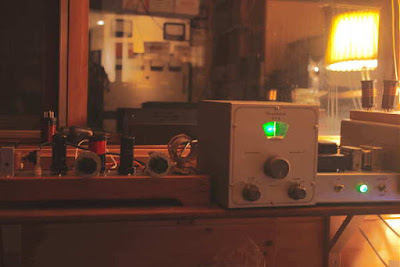 |
| My NRR Setup |
For the low bands (80/40m), the Longfeller was fed into full-sized vertical wire groundplanes made from homebrew ladder line and both fed with the same coaxial feedline.
A counterpoise of eight wire radials were laid on the lawn temporarily with the feedpoint sitting about 20' from the ocean. Being right at the ocean allows me to take advantage of an approximate 6db of "sea gain", effectively turning my 5 watts into 20 watts of radiated power. At times, my signal needed all the help it could get.
It was also exciting to catch the sometimes fleeting transcontinental openings on 15m, as the MUF often struggled to reach 21 MHz each morning. This very much reminded me of past solar cycle peak winters and the morning excitement of watching the MUF slowly climb towards 50MHz, or in some cases, shoot up like a rocket. As Cycle 24 reaches the bottom, the effects of low solar flux values on our higher bands becomes increasingly more evident. I suspect that there will be no 15m transcontinental work in next winter's NRR and who knows how long that might be the case. High MUFs were fun while they lasted ... another thing often taken for granted.
Without question, one of the most interesting parts of the nine day event was following the propagation variances from night to night on 40 and 80m. With a couple of exceptions, low-band propagation was generally pretty good, with one mid-week night being just great. Signals from the east coast to the southern states were strong and with almost no QSB. The Longfeller pushed its 80m signal to Florida, Maryland, New York, Alabama, Louisiana, Ohio and Kentucky. I remember many nights like this when operating 80m back in the early to mid 60's, during the lull between monster Cycle 19 and wimpy Cycle 20. Hopefully we will see more of these really nice transcontinental nights on 80 over the next several years.
For me however, the highlight of the event occurred last Saturday afternoon, while on 40m, fully ninety minutes before our local sunset. I had called WW6D after his 589 CQ only to hear him respond to another NRR local, Mark, CF7MM. He gave Mark's 50 watt DX-60 a '589' and when he finished I called him again ... with not even a whisper of response or even a QRZ. After I called him a third time, he returned to his CQ, leaving no doubt that he wasn't hearing a trace of my signal. Now full-sized 1/4 wave groundplanes mounted beside the ocean are not noted for producing high-angled radiation, which this path would certainly have benefited from, but I would have expected something!
I immediately moved down the band a few kilohertz and sent a short hand-keyed CQ and received an immediate response from WS1K in Plymouth, MA! Jon's signal was a solid and unwavering 559 and he was running only 5 watts as well ... and, he was crystal-controlled! The groundplane had swiftly redeemed itself as this exciting contact went into the log on 40m ... and all in broad daylight! Pictured below is Jon's transcon ether-busting machine ... proof that form does indeed follow function!
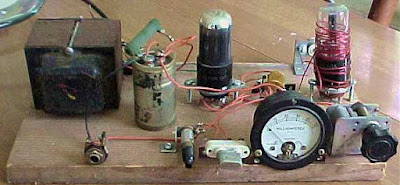 |
| WS1K's 40m Transcon 6V6 Ether-Buster |
I'm really looking forward to next year's NRR but will definitely be running more power. I was impressed with the several Drake 2NT's that I heard and luckily enough, have one such rig in my boatanchor basement. It will be a good project to recap and put back on the air, along with the VF-1, which will also be given the once over to encourage it to behave properly when driving the classy Drake.
Please give the NRR some serious thought for next year ... it's not too early to start planning, refurbishing or to seek out and cherish that aging old beauty, presently hiding in someones attic gathering dust. See you in the NRR!
